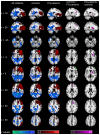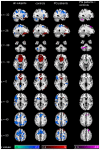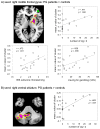Increased functional connectivity between prefrontal cortex and reward system in pathological gambling
- PMID: 24367675
- PMCID: PMC3868704
- DOI: 10.1371/journal.pone.0084565
Increased functional connectivity between prefrontal cortex and reward system in pathological gambling
Erratum in
-
Correction: Increased Functional Connectivity between Prefrontal Cortex and Reward System in Pathological Gambling.PLoS One. 2015 Jul 21;10(7):e0134179. doi: 10.1371/journal.pone.0134179. eCollection 2015. PLoS One. 2015. PMID: 26196675 Free PMC article. No abstract available.
Abstract
Pathological gambling (PG) shares clinical characteristics with substance-use disorders and is thus discussed as a behavioral addiction. Recent neuroimaging studies on PG report functional changes in prefrontal structures and the mesolimbic reward system. While an imbalance between these structures has been related to addictive behavior, whether their dysfunction in PG is reflected in the interaction between them remains unclear. We addressed this question using functional connectivity resting-state fMRI in male subjects with PG and controls. Seed-based functional connectivity was computed using two regions-of-interest, based on the results of a previous voxel-based morphometry study, located in the prefrontal cortex and the mesolimbic reward system (right middle frontal gyrus and right ventral striatum). PG patients demonstrated increased connectivity from the right middle frontal gyrus to the right striatum as compared to controls, which was also positively correlated with nonplanning aspect of impulsiveness, smoking and craving scores in the PG group. Moreover, PG patients demonstrated decreased connectivity from the right middle frontal gyrus to other prefrontal areas as compared to controls. The right ventral striatum demonstrated increased connectivity to the right superior and middle frontal gyrus and left cerebellum in PG patients as compared to controls. The increased connectivity to the cerebellum was positively correlated with smoking in the PG group. Our results provide further evidence for alterations in functional connectivity in PG with increased connectivity between prefrontal regions and the reward system, similar to connectivity changes reported in substance use disorder.
Conflict of interest statement
Figures





Similar articles
-
Pathological gambling and alcohol dependence: neural disturbances in reward and loss avoidance processing.Addict Biol. 2015 May;20(3):557-69. doi: 10.1111/adb.12144. Epub 2014 Apr 22. Addict Biol. 2015. PMID: 24754423
-
Higher volume of ventral striatum and right prefrontal cortex in pathological gambling.Brain Struct Funct. 2015 Jan;220(1):469-77. doi: 10.1007/s00429-013-0668-6. Epub 2013 Nov 16. Brain Struct Funct. 2015. PMID: 24240601
-
Decreased connectivity of the default mode network in pathological gambling: a resting state functional MRI study.Neurosci Lett. 2014 Nov 7;583:120-5. doi: 10.1016/j.neulet.2014.09.025. Epub 2014 Sep 18. Neurosci Lett. 2014. PMID: 25238959
-
Brain imaging studies in pathological gambling.Curr Psychiatry Rep. 2010 Oct;12(5):418-25. doi: 10.1007/s11920-010-0141-7. Curr Psychiatry Rep. 2010. PMID: 20676945 Free PMC article. Review.
-
Neuroimaging of reward mechanisms in Gambling disorder: an integrative review.Mol Psychiatry. 2019 May;24(5):674-693. doi: 10.1038/s41380-018-0230-2. Epub 2018 Sep 13. Mol Psychiatry. 2019. PMID: 30214041 Review.
Cited by
-
Potential Biological Markers and Treatment Implications for Binge Eating Disorder and Behavioral Addictions.Nutrients. 2023 Feb 6;15(4):827. doi: 10.3390/nu15040827. Nutrients. 2023. PMID: 36839185 Free PMC article. Review.
-
Socioeconomic disadvantage and altered corticostriatal circuitry in urban youth.Hum Brain Mapp. 2018 May;39(5):1982-1994. doi: 10.1002/hbm.23978. Epub 2018 Jan 22. Hum Brain Mapp. 2018. PMID: 29359526 Free PMC article.
-
Modulation of Resting Connectivity Between the Mesial Frontal Cortex and Basal Ganglia.Front Neurol. 2019 Jun 5;10:587. doi: 10.3389/fneur.2019.00587. eCollection 2019. Front Neurol. 2019. PMID: 31275221 Free PMC article.
-
Computational and Neural Evidence for Altered Fast and Slow Learning from Losses in Problem Gambling.J Neurosci. 2025 Jan 1;45(1):e0080242024. doi: 10.1523/JNEUROSCI.0080-24.2024. J Neurosci. 2025. PMID: 39557579 Free PMC article.
-
Sex differences of neural connectivity in internet gaming disorder and its association with sleep quality: an exploratory fMRI study.Front Psychiatry. 2024 May 30;15:1379259. doi: 10.3389/fpsyt.2024.1379259. eCollection 2024. Front Psychiatry. 2024. PMID: 38873537 Free PMC article.
References
-
- American Psychiatric Association (2013) Diagnostic and statistical manual of mental disorders. Arlington, VA, American: Psychiatric Publishing.
-
- Diekhof EK, Gruber O (2010) When desire collides with reason: functional interactions between anteroventral prefrontal cortex and nucleus accumbens underlie the human ability to resist impulsive desires. J Neurosci 30: 1488-1493. doi:10.1523/JNEUROSCI.4690-09.2010. PubMed: 20107076. - DOI - PMC - PubMed
-
- Diekhof EK, Nerenberg L, Falkai P, Dechent P, Baudewig J et al. (2012) Impulsive personality and the ability to resist immediate reward: An fMRI study examining interindividual differences in the neural mechanisms underlying self-control. Hum Brain Mapp 33: 2768-2784. doi:10.1002/hbm.21398. PubMed: 21938756. - DOI - PMC - PubMed
Publication types
MeSH terms
LinkOut - more resources
Full Text Sources
Other Literature Sources
Medical

